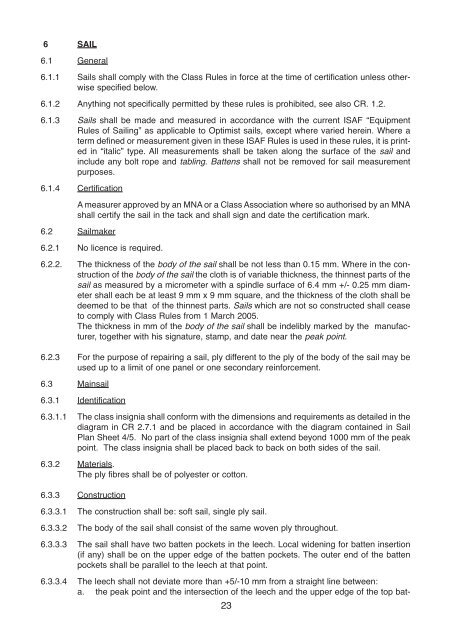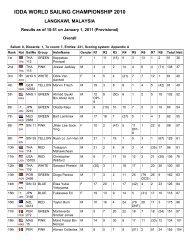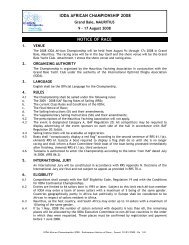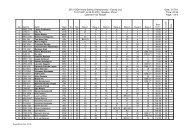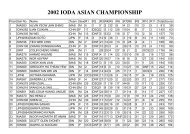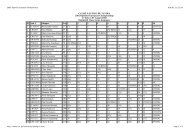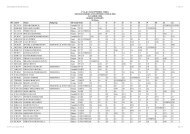2011 INTERNATIONAL OPTIMIST CLASS RULES
2011 INTERNATIONAL OPTIMIST CLASS RULES
2011 INTERNATIONAL OPTIMIST CLASS RULES
You also want an ePaper? Increase the reach of your titles
YUMPU automatically turns print PDFs into web optimized ePapers that Google loves.
6 SAIL<br />
6.1 General<br />
6.1.1 Sails shall comply with the Class Rules in force at the time of certification unless otherwise<br />
specified below.<br />
6.1.2 Anything not specifically permitted by these rules is prohibited, see also CR. 1.2.<br />
6.1.3 Sails shall be made and measured in accordance with the current ISAF “Equipment<br />
Rules of Sailing” as applicable to Optimist sails, except where varied herein. Where a<br />
term defined or measurement given in these ISAF Rules is used in these rules, it is printed<br />
in “italic” type. All measurements shall be taken along the surface of the sail and<br />
include any bolt rope and tabling. Battens shall not be removed for sail measurement<br />
purposes.<br />
6.1.4 Certification<br />
A measurer approved by an MNA or a Class Association where so authorised by an MNA<br />
shall certify the sail in the tack and shall sign and date the certification mark.<br />
6.2 Sailmaker<br />
6.2.1 No licence is required.<br />
6.2.2. The thickness of the body of the sail shall be not less than 0.15 mm. Where in the construction<br />
of the body of the sail the cloth is of variable thickness, the thinnest parts of the<br />
sail as measured by a micrometer with a spindle surface of 6.4 mm +/- 0.25 mm diameter<br />
shall each be at least 9 mm x 9 mm square, and the thickness of the cloth shall be<br />
deemed to be that of the thinnest parts. Sails which are not so constructed shall cease<br />
to comply with Class Rules from 1 March 2005.<br />
The thickness in mm of the body of the sail shall be indelibly marked by the manufacturer,<br />
together with his signature, stamp, and date near the peak point.<br />
6.2.3 For the purpose of repairing a sail, ply different to the ply of the body of the sail may be<br />
used up to a limit of one panel or one secondary reinforcement.<br />
6.3 Mainsail<br />
6.3.1 Identification<br />
6.3.1.1 The class insignia shall conform with the dimensions and requirements as detailed in the<br />
diagram in CR 2.7.1 and be placed in accordance with the diagram contained in Sail<br />
Plan Sheet 4/5. No part of the class insignia shall extend beyond 1000 mm of the peak<br />
point. The class insignia shall be placed back to back on both sides of the sail.<br />
6.3.2 Materials.<br />
The ply fibres shall be of polyester or cotton.<br />
6.3.3 Construction<br />
6.3.3.1 The construction shall be: soft sail, single ply sail.<br />
6.3.3.2 The body of the sail shall consist of the same woven ply throughout.<br />
6.3.3.3 The sail shall have two batten pockets in the leech. Local widening for batten insertion<br />
(if any) shall be on the upper edge of the batten pockets. The outer end of the batten<br />
pockets shall be parallel to the leech at that point.<br />
6.3.3.4 The leech shall not deviate more than +5/-10 mm from a straight line between:<br />
a. the peak point and the intersection of the leech and the upper edge of the top bat-<br />
23


